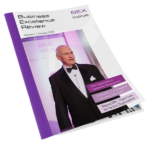The Total Quality Management (TQM) movement started in Japan and spread as people recognised the tremendous benefits. In the late 80s and early 90s, the Baldrige Model and EFQM Model appeared in the US and Europe – holistic management frameworks that went beyond the product to look at all aspects of the business. Initially, these were championed by many high-profile organisations and TQM was “the hot topic” on the management agenda. Its popularity peaked in the 90s; since then there has been a steady decline. Now excellence models tend to be used in discrete pockets within a large company, like a single manufacturing site, or within the public sector. So what went wrong…?
Part of the reason lies within HOW these Models where used – another part lies with WHO was using them. Excellence Models are designed as holistic tools – they cover all aspects of the organisation from the Leadership & Strategy through People and Resource Management through to Product Development & Delivery and, finally, Customer Relationship Management.
However, the “QM” in TQM was usually interpreted as “Quality Management”. This interpretation meant it was often coupled with process management, product quality and ISO 9000 certification. It was the job of the Quality Manager, not line management. Don’t get me wrong – product quality and quality management are very important. But the holistic excellence models went far beyond these traditional boundaries.
Over the years, I’ve had the privilege to work with some Quality Managers who were capable of applying excellence models at a strategic level – most of them have since moved on to more senior roles. But I’ve also worked with many who tried to use excellence models as a check-list – something it’s not designed for and something that tends to produce generic, meaningless feedback.
This is nothing new. We all know that the success of any organisational development initiative depends more heavily on the individuals selected to deploy it than the tool itself. If the wrong people are involved, it doesn’t matter how good the tool is… and if you’re looking at a tool that applies to the whole organisation, you can’t only involve people from a single function.
Fast forward 20+ years to today. We find a number of “excellence evangelists” who are completely convinced that excellence models work and freely eulogise about the benefits to all who will listen. Some are lucky enough to be in organisations where they are supported but many more are not and therefore can’t “practice what they preach”. They’re often met with comments like “we tried that before and it didn’t work”. I’m sure you recognise these people – or maybe you are one yourself. At conferences and events, we see the “same old faces” year after year. Where’s the new blood? The new ideas? The “next generation”…?
We know that, if applied correctly, excellence models can deliver great benefits. We also know that “management fads” come in cycles. The vast majority of CEOs interviewed place topics like sustainability, competitiveness and innovation high on their priority lists. Topics the excellence models were designed to address. But we must learn the lessons of the past. Excellence is not “quality management”. It’s not just the domain of operations and it is definitely not a staff function. It wasn’t in Japan and it helped them build one of the world’s strongest economies.
So, where does this leave us? If we’re going to re-energise the excellence movement, we need a new approach. Look at the success of Six Sigma – the vast majority of the tools in the toolkit went back to the 1950s. Someone just added new packaging. Can we do the same with “excellence”?
To me, it seems simple. It seems we’re missing a single two-letter word. “OF”. Excellence Models are not about Quality Management. They’re about the Quality OF Management. To be able to talk credibly about the Quality OF Management clearly requires a different skill set and different experience. But there are many people who gained some experience in quality management over the past 20 years who are now in “senior management” positions. People who know the potential of this tool and are now in a position to use it at a strategic level.
It’s time for some new thinking…















